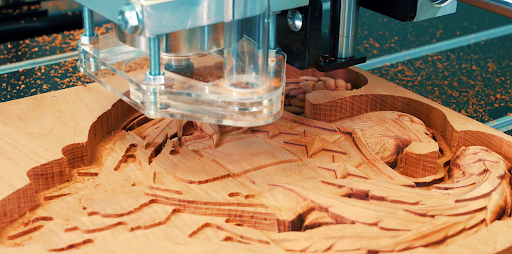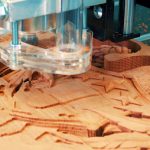Woodworking has evolved significantly from manual, labor-intensive methods to advanced, technology-driven processes. Central to this transformation is the CNC wood router, a machine that has revolutionized the woodworking industry. Whether you’re a professional woodworker, a small business owner, or a hobbyist, understanding what a CNC wood router is and how it operates can be incredibly beneficial. It opens up new possibilities for precision, efficiency, and creativity in woodworking projects.
A CNC (Computer Numerical Control) wood router is a machine that automates the process of cutting, carving, and shaping wood. Unlike traditional wood routers that rely on manual operation, CNC routers are controlled by computer software. This allows for precise and repeatable cuts, significantly improving the quality and speed of woodworking projects. In this article, we will discuss the fundamentals of CNC wood routers, explore how they function, and examine their various advantages.
What is a CNC Router?
A CNC router is a sophisticated machine that uses computer software to control the movement of a cutting tool. The machine operates along multiple axes, typically the X, Y, and Z axes, allowing it to create intricate designs, shapes, and patterns in various materials. While CNC routers can work with various materials such as plastics, metals, and composites, they are particularly well-suited for woodworking.
The main components of a CNC router include the router spindle, the worktable, the drive system, and the control system. The router spindle holds the cutting tool and rotates high speeds to cut through the material. The worktable provides a stable surface for the cut material, ensuring it remains secure during the operation. The drive system moves the router spindle along the designated axes, while the control system, often called the machine’s brain, interprets the computer program and directs the router’s movements accordingly.
CNC routers are available in various sizes and configurations, ranging from compact desktop models designed for hobbyists to large industrial machines used in manufacturing. Their versatility allows them to perform various tasks, from simple engraving to complex 3D carving. This flexibility, combined with their precision and efficiency, makes CNC routers indispensable tools in modern woodworking.
Thanks to advancements in technology and reductions in cost, CNC routers have also become more accessible to small businesses and individual craftsmen. This accessibility has allowed more people to take advantage of the benefits offered by CNC routers, leading to a surge in creativity and innovation in the woodworking community. With a CNC router, even small-scale operations can produce high-quality, intricate designs that would have been difficult or impossible to achieve with traditional tools.
Can a CNC Router Work on Wood?
CNC routers are highly effective when it comes to working with wood. In fact, woodworking is one of the most common applications for CNC routers. The precision and control offered by CNC routers make them ideal for creating detailed and intricate designs in wood, whether for furniture, cabinetry, decorative items, or even artistic pieces.
When working with wood, CNC routers can perform various operations, including cutting, drilling, engraving, and shaping. They can be used on different types of wood, ranging from softwoods like pine and cedar to hardwoods like oak, walnut, and maple. The type of wood being used, along with the desired outcome, will influence the selection of the cutting tool, as well as the speed and depth of the cuts.
One of the primary advantages of using a CNC router for woodworking is its consistency. Because a computer program controls the machine, it can reproduce the same design multiple times with exact precision. This consistency is particularly beneficial in production environments where uniformity is crucial. Whether producing a batch of identical parts or creating a series of custom pieces, a CNC router ensures that each item meets the specifications.
Moreover, CNC routers are highly customizable, allowing woodworkers to tailor the machine’s operation to their needs. For example, the cutting tool, feed rate, and depth of cut can be adjusted to suit the wood’s characteristics. This level of customization ensures that the CNC router can handle various woodworking tasks, from simple cuts to complex 3D carvings.
Pros of CNC Router Wood
The use of CNC routers in woodworking offers a wide range of advantages that make them an attractive option for professionals and hobbyists. These versatile machines bring efficiency, precision, and creativity to woodworking. Here’s a closer look at the benefits of using a CNC router for wood:
- Precision and Accuracy: One of the most significant advantages of CNC routers is their ability to produce precise and accurate cuts. The computer-controlled system ensures that the cutting tool follows the exact path defined by the program, resulting in clean, sharp edges and consistent dimensions. This level of accuracy is difficult to achieve with manual tools, especially when working on complex designs.
CNC routers can achieve precision that is simply unattainable with hand tools or even some other automated equipment. The machine’s ability to move the cutting tool along multiple axes with micrometer-level precision ensures that every cut is strictly as intended. This precision is particularly important in applications requiring tight tolerances, such as in producing intricate furniture or detailed architectural components.
- Efficiency and Speed: CNC routers can significantly speed up the woodworking process. Once the design is programmed into the machine, the router can execute the cuts quickly and efficiently. This is particularly beneficial in production environments where time is of the essence. CNC routers can easily handle repetitive tasks, allowing woodworkers to complete projects faster and with less manual labor.
In addition to increasing production speed, CNC routers reduce the time spent on setup and adjustments. Traditional woodworking methods often require multiple tools and jigs to achieve the desired result. With a CNC router, all these tasks can be consolidated into a single operation, reducing the time and effort required to complete the project. This efficiency saves time and reduces labor costs, making CNC routers cost-effective for woodworking businesses.
- Versatility: CNC routers are incredibly versatile and can be used for various woodworking tasks. Whether cutting, engraving, drilling, or shaping, a CNC router can handle everything. Additionally, CNC routers can work with various types of wood, from softwoods to hardwoods, making them suitable for different applications and projects.
The versatility of CNC routers extends beyond their ability to work with different types of wood. These machines can also be equipped with various cutting tools and attachments, allowing them to perform various operations. For example, a CNC router can be used to create intricate carvings, cut complex joinery, or even engrave detailed patterns into the surface of the wood. This versatility makes CNC routers an invaluable tool for woodworkers who need to perform multiple tasks with a single machine.
- Consistency and Repeatability: One of the challenges in woodworking is maintaining consistency across multiple pieces. With a CNC router, this is no longer an issue. The machine can reproduce the same design multiple times with exact precision, ensuring that each piece is identical. This is particularly important in manufacturing and production settings where uniformity is crucial.
Consistency is critical in woodworking, especially in production environments requiring large quantities of identical parts. A CNC router ensures that every piece is cut to the same dimensions, eliminating variations that can occur with manual cutting methods. This repeatability is particularly important in applications such as cabinetry, where uniformity ensures that all parts fit together correctly.
- Complex Designs and 3D Carving: CNC routers excel at creating complex designs and 3D carvings that would be challenging or impossible to achieve with traditional tools. The ability to program intricate patterns and shapes into the machine allows woodworkers to explore new levels of creativity and produce unique, detailed pieces.
One of the most exciting aspects of CNC routers is their capability to create complex designs and 3D carvings. With the right software, woodworkers can design and produce intricate patterns, detailed reliefs, and even full 3D sculptures. This opens up new possibilities for artistic expression and allows woodworkers to create pieces that would be difficult or impossible to achieve with traditional tools.
- Reduced Waste: CNC routers are designed to maximize material usage and minimize waste. The machine’s precision ensures that cuts are made accurately, reducing the amount of scrap material. This not only saves money but also contributes to more sustainable woodworking practices.
Waste reduction is a significant benefit of using CNC routers. Because the computer program precisely controls the machine’s movements, cuts are made exactly where they are needed, minimizing wasted material. This is particularly important when working with expensive hardwoods, where every inch of material counts.
- Automation and Reduced Labor: CNC routers automate the cutting process, reducing the need for manual labor. This is particularly beneficial in large-scale production environments where manual operation would be time-consuming and labor-intensive. By automating the process, woodworkers can focus on other aspects of the project, such as design and finishing.
Automation is one of the critical advantages of CNC routers. By automating the cutting process, these machines allow woodworkers to complete projects with less manual labor. This reduces labor costs and frees time for other tasks like design, assembly, and finishing. In large-scale production environments, the ability to automate repetitive tasks can lead to significant increases in productivity and efficiency.
- Safety: CNC routers enhance safety in the workshop. Automating the cutting process means that operators are not directly handling the cutting tool, reducing the risk of accidents and injuries. Additionally, CNC routers have safety features that help prevent mishaps, such as emergency stop buttons and protective enclosures.
Safety is a critical consideration in any woodworking operation, and CNC routers offer several features that enhance safety in the workshop. By automating the cutting process, these machines reduce the need for operators to handle sharp tools or make potentially dangerous cuts manually. Additionally, many CNC routers have safety features such as emergency stop buttons, protective enclosures, and sensors that detect obstructions or malfunctions. These features help prevent accidents and ensure that the machine operates safely.
- Customization and Flexibility: With a CNC router, customization is easier than ever. Whether creating a single custom piece or producing a batch of personalized items, the machine can be programmed to execute the design precisely. This flexibility allows woodworkers to offer customized products to their clients, adding value to their services.
One of the most appealing aspects of CNC routers is the ability to customize designs. Whether creating a single custom piece or producing a batch of personalized items, the machine can be programmed to execute the design precisely. This flexibility allows woodworkers to offer customized products to their clients, adding value to their services. Customization is particularly important in today’s market, where consumers increasingly demand unique, personalized products.
- Easy Reprogramming: CNC routers offer the advantage of easy reprogramming, allowing woodworkers to switch between different designs and projects quickly. This adaptability is particularly useful in dynamic production environments where the ability to respond to changing demands is crucial. With just a few adjustments to the program, the machine can be set up for a new task in no time.
Reprogramming a CNC router is a straightforward process allowing woodworkers to switch between different designs and projects quickly. This adaptability is particularly useful in dynamic production environments where the ability to respond to changing demands is crucial. With just a few adjustments to the program, the machine can be set up for a new task in no time. This flexibility increases efficiency and allows woodworkers to take on a broader variety of projects.
Conclusion
The CNC wood routing is a transformative tool in the world of woodworking. Its ability to automate, precision-cut, and create complex designs in wood has opened up new possibilities for woodworkers of all skill levels. Whether you are a professional looking to increase efficiency, a small business owner aiming to offer customized products, or a hobbyist seeking to explore new creative avenues, a CNC wood router offers the tools you need to succeed.
By understanding how a CNC wood router works and its benefits, you can make informed decisions about incorporating this technology into your woodworking projects. Investing in a CNC router is not just about acquiring a new tool; it’s about expanding your capabilities, improving your craftsmanship, and staying competitive in an ever-evolving industry.










